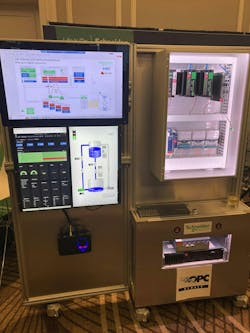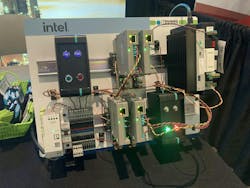Ever since the Open Process Automation Standard (O-PAS), V2.1, was published a year ago, suppliers and their partners have been working furiously to develop products that follow the standard’s interoperability principles and can soon be certified as complying with it. Several were announced at the ARC Advisory Group’s Industry Leadership Forum on Feb. 4-8 in Orlando, Fla.
The 15-member Coalition for Open Process Automation (COPA) reported that ASRock’s iEP-7020E IIoT controller with COPA-member Intel’s 13th Gen Core processor and iEP-5010G IIoT controller with Intel’s Atom x6000 processor are the first two DCNs to successfully complete verification testing for the OSM-003 profile. iEP-7020E also operates reliably from -40 °C to 70 °C. Both are expected to be certified in 2Q24.
“The power and flexibility of these DCNs in an open-system architecture are pivotal for the future of digital innovations in process manufacturing,” says German Carmona, global president of digital consulting at Wood, which has been helping integrate several O-PAS projects. “They’re not just transforming the way we think about control systems, but also how we implement them in achieving efficiency and performance."
Schneider Electric’s ACP and DCN
Similarly, Schneider Electric reported that it’s collaborated with Intel and Red Hat to release their DCN software framework as an extension of its EcoStruxure Automation Expert’s Soft dPAC software. It will reportedly allow users to move to a software-defined, plug-and-produce, network-based experience and solution, enhance operations, ensure quality, reduce complexity, and optimize costs. The framework’s two main parts include: an ACP that runs the system management application to supervise the control workload by providing content control and automation capabilities needed to deploy those workloads securely and programmatically, as well as virtualization and monitoring functionalities; and DCNs that are low-power, industrial systems using Intel’s Atom x6400E series processors, and dedicated to running controls and designed for workloads of mixed-criticality.
In an exhibit at the ARC event, Schneider showed how its Soft dPAC software can run control in an Intel OPA reference-design DCN and ASRock IPC DCN with R. Stahl I/O, and maintain bumpless control if one of the units goes offline or fails, and switch the workload to any other available resource on the network, including a supervisory Intel server running as an ACP to re-establish the as-designed configuration without human intervention (Figure 1).
“The difference with this solution is it avoids disruptions, manages obsolescence, and automates system management functions like switchovers, so specialized knowledge isn’t no longer required,” said Andre Babineau, process automation strategy director at Schneider Electric. “If users wanted this high-availability in the past, they’d have to buy two PLCs with the same firmware and software, and run them side-by-side all the time. With two DCNs running the same control engine, it’s much easier to replace anything, and patch or upgrade software anytime. They aren’t O-PAS texted or certified yet, but we’ll be doing it soon.”
Nathalie Marcotte, SVP of process automation at Schneider Electric, added, “This project is the culmination of two years of co-innovation to create efficient, future-proof DCSs. The DCN framework is key to fostering an open-automation approach, enabling industrial businesses to grow and innovate for the future. Its interoperability and portability help our customers enjoy the freedom of shaping technology around their business needs—and not the other way around.”
Phoenix Contact’s configurable I/O and connectors
As part of its work on the O-PAS physical platform subcommittee, COPA-member Phoenix Contact has collaborated with Intel to develop a 10BASE-T1S, multidrop-Ethernet backplane demonstrator that shows the I/O subsystem possibility that multiple I/O stations can communicate with a distributed control node via a single, twisted pair cable with T1S PHYs.
“We’ve helped develop O-PAS from the beginning to help end-users achieve their goals of being able to use the software and hardware that best fits their processes,” added Norris. “They want standardized, plug-and-play components, interfaces and configurations, so Phoenix Contact has participated in ExxonMobil’s field trials, and supports DCNs for them. We’re also invested in developing I/O interfaces for directly connecting to OCF network, such as a standardized interface in our PLCnext controller. It can support whatever third-party software makes sense for each user, and includes specific O-PAS interfaces and I/O with analog inputs and outputs, digital inputs and outputs, and temperature measurements, both in hazardous areas via intrinsic safety and non-hazardous areas.”







